Potrebujeme váš súhlas na využitie jednotlivých dát, aby sa vám okrem iného mohli ukazovať informácie týkajúce sa vašich záujmov. Súhlas udelíte kliknutím na tlačidlo „OK“.
ASTM D5362-13
Standard Test Method for Snagging Resistance of Fabrics (Bean Bag)
Automaticky preložený názov:
Štandardná skúšobná metóda pre zablokovanie odporu textílií (Bean Bag)
NORMA vydaná dňa 1.7.2013
Informácie o norme:
Označenie normy: ASTM D5362-13
Poznámka: NEPLATNÁ
Dátum vydania normy: 1.7.2013
Kód tovaru: NS-30882
Počet strán: 8
Približná hmotnosť: 24 g (0.05 libier)
Krajina: Americká technická norma
Kategória: Technické normy ASTM
Kategórie - podobné normy:
Anotácia textu normy ASTM D5362-13 :
Keywords:
knitted fabrics, snagging resistance, woven fabric, ICS Number Code 59.080.30 (Textile fabrics)
Doplňujúce informácie
| Significance and Use | ||||||||||||||||||||
|
5.1 Acceptance Testing—This test method may be used for acceptance testing of commercial shipments of fabrics because the precision is acceptable (see 5.1.1 If there are differences of practical significance between reported test results for two laboratories (or more), comparative tests should be performed to determine if there is a statistical bias between them, using competent statistical assistance. As a minimum, use the samples for such a comparative test that are as homogeneous as possible, drawn from the same lot of material as the samples that resulted in disparate results during initial testing and randomly assigned in equal number to each laboratory. The test results from the laboratories involved should be compared using a statistical test for unpaired data, at a probability level chosen prior to the testing series. If bias is found, either its cause must be found and corrected, or future test results for that material must be adjusted in consideration of the known bias. 5.2 This test method may be used for quality control testing of fabrics during manufacturing and product comparisons of different fabrics by manufacturers, retailers, and users. This test method may also be used by researchers to examine the effect of new fibers, yarns, fabric constructions, and finishes on the snagging resistance of fabrics. 5.3 This test method may be used to test the snagging resistance of most apparel and home furnishings fabrics. However, a different test method (see 5.3.1) may be needed for different types of fabrics and different end-uses (such as towels, swimwear, slacks, and upholstery). 5.3.1 Some fabrics which may not be suitable for this test method are described in 1.2. Many open construction fabrics can be tested for snagging resistance using AATCC Test Method 65. Many heavy or stiff fabrics can be tested for snagging resistance using Test Method D3939. The snagging resistance of many pile floor coverings can be tested by Test Method D1335. 5.4 Because fabric snagging can be affected by laundering or drycleaning, it may be advisable to test the snagging resistance of a fabric before and after laundering or drycleaning. 5.5 The snagging resistance of a specific fabric varies with individual wearers and general conditions of use. Therefore, it can be expected that garments of the same fabric will show a fairly wide snagging resistance spectrum after wear and much greater variation in wear than in replicate fabric specimens subjected to controlled laboratory tests. This factor should be considered when adopting levels of acceptability for any specification that includes snagging resistance. 5.6 Snags observed in worn garments vary appreciably in number and appearance. The appearance of a snag depends particularly on (1) the degree of color contrast between the snag and the surrounding area of the fabric, or, (2) the presence of long distortions or long protrusions. These conditions are not evaluated when snagging is rated solely on the number of snags. See Section 3 for a description of terminology such as color contrast, distortion, and protrusion See Figs. 1-3 . Because the overall acceptability of a specific fabric is dependent on both the characteristics of the snags and other factors affecting fabric appearance, it is recommended that fabrics tested in the laboratory be evaluated with regard to the defects which may be visually observed and not rated solely on the number of snags developed. A series of visual rating standards (see 1.1 This test method determines the snagging resistance of a fabric. 1.2 Studies of fabric snagging have shown that this test method is suitable for a range of woven and knitted fabrics made from textured or untextured filament yarns or spun yarns or combinations of these yarns.2 ,1.3 The values stated in either acceptable metric units or in other units shall be regarded separately as standard. The values stated in each system may not be the exact equivalents; therefore, each system must be used independently of the other, without combining values in any way. In case of referee decisions the metric units will prevail. 1.4 This standard does not
purport to address all of the safety concerns, if any, associated
with its use. It is the responsibility of the user of this standard
to establish appropriate safety and health practices and determine
the applicability of regulatory limitations prior to use.
Standard Test Method for Snagging
Resistance of Fabrics (Mace) Standard Terminology Relating to Care
Labeling for Apparel, Textile, Home Furnishing, and Leather
Products Standard Practice for Conditioning and
Testing Textiles Standard Test Method for Tuft Bind of
Pile Yarn Floor Coverings Standard Terminology Relating to
Textiles Standard Test Method for Bond Strength of
Bonded, Fused, and Laminated Apparel Fabrics 135 Test Method for Dimensional Changes in
Automatic Home Laundering of Woven and Knit Fabrics 65 Test Method for Snag Resistance of Womens
Nylon Hosiery (see ) Standard Terminology Relating to Fabrics
and Fabric Test Methods Standard Practice for Interlaboratory
Testing of a Textile Test Method That Produces Non-Normally
Distributed Data (Withdrawn 2010) |
Podobné normy:
Historická
1.7.2013
Historická
15.2.2014
Historická
1.1.2010
Historická
1.1.2014
Historická
1.5.2013
Historická
1.7.2012
Odporúčame:
Aktualizácia zákonov
Chcete mať istotu o platnosti využívaných predpisov?
Ponúkame Vám riešenie, aby ste mohli používať stále platné (aktuálne) legislatívne predpisy
Chcete vedieť viac informácií ? Pozrite sa na túto stránku.


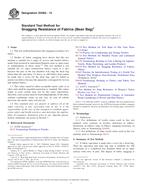
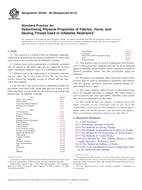 ASTM D5446-08(2013)..
ASTM D5446-08(2013)..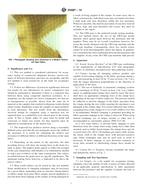 ASTM D5587-14
ASTM D5587-14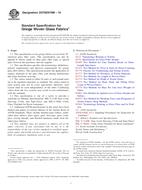 ASTM D579/D579M-10..
ASTM D579/D579M-10..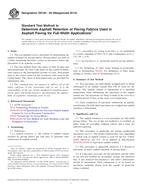 ASTM D6140-00(2014)..
ASTM D6140-00(2014)..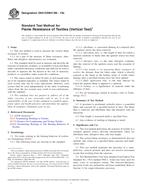 ASTM D6413/D6413M-13..
ASTM D6413/D6413M-13.. ASTM D6476-12
ASTM D6476-12
 Cookies
Cookies
